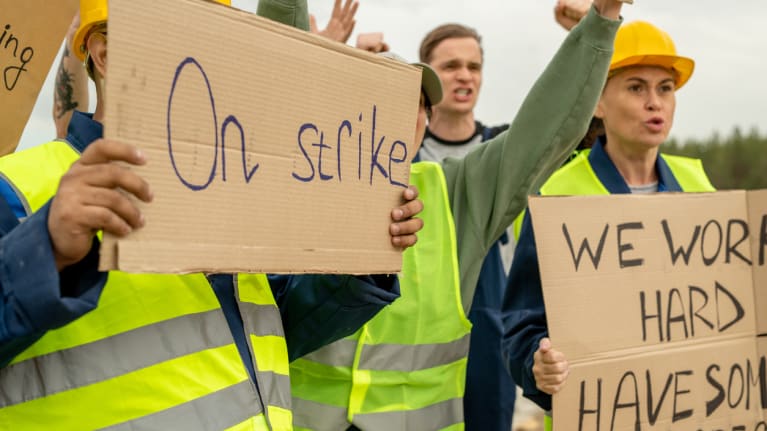

?The U.S. Supreme Court heard oral arguments on Jan. 10 for a case that could shed light on when workers can strike.
The National Labor Relations Act (NLRA) gives workers the right to strike, but those protections don’t apply if workers fail to take reasonable precautions to avoid foreseeable, imminent damage to the employer’s property, such as the building, equipment or products.
Glacier Northwest, a building material company in Seattle, sued its employees’ union, the International Brotherhood of Teamsters, after workers started a strike when concrete was scheduled to be batched and delivered. The company claimed the striking workers intentionally sabotaged its business operations and property because they waited until the concrete was loaded into the trucks to strike.
The union argued that the state-law claims were preempted under the U.S. Supreme Court’s decision in San Diego Building Trades Council v. Garmon. In that case, the court found that NLRA preempts some state law when the conduct is arguably protected or arguably prohibited. In Glacier Northwest’s case, a Washington State trial court agreed that the state law against intentional property destruction was preempted because the damage did not involve vandalism or violence. The Washington Court of Appeals agreed, stating that the strike was arguably protected as a legitimate bargaining tactic.
The Biden administration filed a friend of the court brief, concluding that Glacier’s lawsuit goes too far, to the extent it would cover any property damage that results from any strike, regardless of the timing. It said employers can resist the economic pressure of a strike by locking workers out, hiring new workers to replace strikers, or using existing workers who have not gone on strike to fill in for those who have.
Timing of Strikes
Strikes aren’t permitted if they result in intentional property damage. “That’s why steelworkers can’t walk out in the middle of a molten iron pour. It’s why federal security guards can’t leave their posts in the middle of a terrorist threat. It’s why a ferry boat crew can’t drive their boat out into the middle of the river and abandon ship,” said Noel Francisco, an attorney representing Glacier Northwest.
Justice Sonia Sotomayor asked, “Could a state tell the union, ‘Don’t go on strike except at the end of the day?'” Francisco said no, it couldn’t.
“When it comes to destruction of property, I always thought you needed a duty that you’re breaching,” Sotomayor said. “If an employee goes on strike, their duty to you has ended. I can walk by your plant and the parking lot and see those trucks running. I have no obligation to tell you there’s cement in there. I have no obligation to move the truck … The moment I walked out on strike, I didn’t owe you a duty to protect your property from self-perishment.”
Chief Justice Roberts said, “It just seems to me that intentional destruction of property is a much more serious concern than failure to take reasonable precautions, even if you want to add imminent and all that other stuff.”
“There is a meaningful distinction between the spoilage of products that happens in the ordinary course and the type of harm that is alleged in this case,” said Vivek Suri, a lawyer representing the Biden administration. “The mere spoilage of a perishable product after people walk off from the job is not something that the striking employees can be held responsible for.”
“I still feel like that could be inconsistent with some of our precedents,” said Justice Ketanji Brown Jackson. “I thought the real problem in some of our cases, in the molten metal case, was the sort of conspiratorial deliberate timing of this to inflict maximum property damage, but it seems to me that imminent problem to the product covers milk, too.”
She suggested focusing “on the intent, on the conspiratorial nature of this, on the attempt to hurt the employer, as opposed to just the intent to exercise my right to strike, and the incidental damage that happens to that, so be it.”
Darin Dalmat, an attorney representing the union, said all strikes intend to inflict economic harm. He noted that the Teamsters union used reasonable precautions, including instructing the drivers to return their trucks to the worksite with the drums turning to protect the concrete.
Preemption Question
Much of the oral arguments were devoted to when and how the NLRA preempts state tort claims. The state court still has jurisdiction to decide whether the facts of the case actually or arguably implicate federal law, even if preemption might be reasonably granted, Francisco argued.
But Suri said, “The board makes factual findings to be resolved under the substantial evidence standard. That suggests that Congress wanted the board to make these factual decisions, as well as the legal ones … The standard [for preemption] is whether a party has presented evidence from which the board could reasonably conclude that the conduct is protected.”
Jackson agreed: “As long as it is possible, it is arguable that we have protected conduct here, then the states need to stand down and allow the board to go forward.”
Francisco replied, “State courts get to proceed in the ordinary course, just like they do in virtually every other area of preemption law.”
Justice Elena Kagan said the NLRB has seen thousands of strikes, so “as a controversy gets more and more factual, you might think that that’s where the board’s expertise more and more comes into play.”
Justice Amy Coney Barrett said Garmon provides a “a different and more expansive kind of preemption.”
In a friend of the court brief, the U.S. Chamber of Commerce argued that preemption isn’t required if the conduct, like a strike, is so closely tied to local interests that state courts should be allowed to intervene. It said this exception applies to intentional property destruction.
It’s unclear when the court will issue a final ruling in this case, but most likely it will happen before the court recesses in June.
